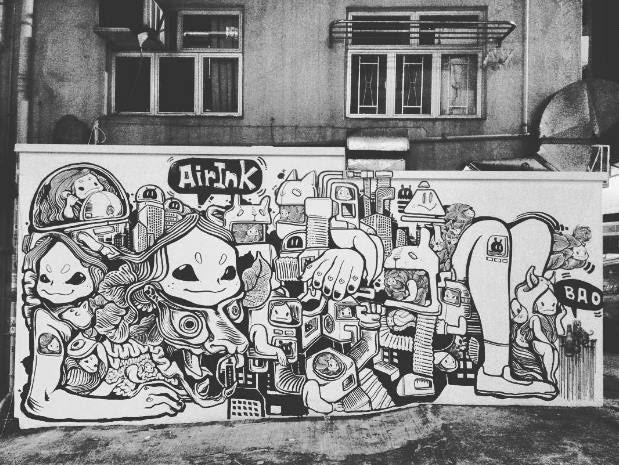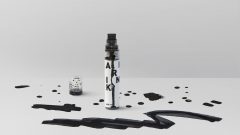
Even air pollution can yield something positive, such as the beauty of art.
When soot spewed by vehicular tailpipes is captured, it can be turned into art material. Which is what Graviky Labs, a Bengaluru-based start-up, is doing with one of the perils of the modern age: vehicular pollution.
For some years now, the company has been working on an innovative method to trap soot from vehicles and transform it into ink.
The team of industrial and automobile engineers, computer scientists and design enthusiasts developed a proprietary, retrofit device —called Kaalink— that can be attached to a vehicle’s tail pipe to filter out residual soot. This is then chemically-processed and turned into a purified carbon pigment that in turn becomes Air-Ink.

Air-Ink product produced from pollution
The unit captures 95% of the particulate matter emanating from the engine without inducing back-pressure in the vehicle. Kaalink is currently undergoing certification and being tested in several pilot demonstrations. The unit is designed to work on Indian roads and fitted with heat and water-proof electronics and materials.
Graviky’s products turn the darkness of pollution into bold strokes. Their range currently includes marker pens with tips of various thicknesses, which respectively contain from 40 up to 130 minutes of captured diesel car pollution. In the future, the ‘art from pollution’ series will include oil-based paints, fabric paints and outdoor paints.
Soot is mostly made up of fine black particles and carbon produced by incomplete combustion of fossil fuels. The particles are extremely tiny: 2.5 micrometres or less in diameter which is smaller than dust, and linked to public health: causing a variety of respiratory diseases, and even cancer.
The problem of fine particulates is growing universally. A Greenpeace report released earlier this year found that 90% of Indian cities it studied had pollution levels over prescribed standards. Data for the year 2015 analysed as part of this study showed that 154 of 168 cities had an average Particulate Matter level higher than the national standard. None of the cities had air quality matching the standard prescribed by the World Health Organization.
Delhi was found to be the most polluted city, with the annual average for PM10 being 268 micrograms per cubic metre, which is more than four times the 60 micrograms/cubic metre limit prescribed in the National Ambient Air Quality Standards of the Central Pollution Control Board.
Anirudh Sharma, a co-founder, has said that he conceived of the Air Ink idea during a stint at the Massachusetts Institute of Technology- Media Lab.
At first, the idea was to build a handheld printer that prints from candle soot, and Mr. Sharma demonstrated an early prototype at several conferences. “We quickly learned that environmentalists and artists loved it,” a company statement said.
“We thought what if we could use it as a pigment for colouring? We tied up with several designers, artists, chemists, and automobile experts to make this a reality. Since then, we have made a significant effort to bring this concept to reality,” he told The Hindu at the time.
Search for funds
Currently the company is on a ‘Kickstarter’ campaign, which is a crowd-sourced operation that allows people to pledge a certain amount of money to support innovative services or products. “People from all over constantly ask us how they can get their hands on AIR-INK and use it in their everyday lives. But at this time our pollution capture process is very labour intensive and can only happen on a very small scale. This campaign will allow us to scale up and make AIR-INK more widely accessible,” the company said in a statement.
Having filed for patents, the company plans to expand beyond automobiles and branch out into collection of soot from different sources of pollution such as chimneys and generators. And of course fit Kaalink capture devices to as many vehicles as they can.
Nikhil Kaushik, director at Graviky Labs and a chartered accountant by training, said the company would continue to be focused on ways to reach artists and convince them that they would be doing their bit for the environment by using soot-based ink. The other major effort is to tap large vehicles. “We are in talks with several large cargo fleets to be able to harness their engine soot,” he said in a phone conversation with The Hindu.
In a February interview to technology magazine Wired, Mr. Sharma said the company has installed 75 kits and captured about 100 kg of Particulate Matter, which can go to make 1,000 litres of ink. “Even if just 15% of the world’s black ink supply is replaced with Air Ink, we could end up sequestering a lot of air pollution,” he said. The company claims that it has so far captured 1.6 billion micrograms of Particulates which equates to cleaning 1.6 trillion litres of outdoor air.
Written by: Jacob Koshy
This article was originally published in The Hindu and reposted by Egypt Independent as part of our participation in Impact Journalism Day on which 50 of the world’s leading newspapers feature 60 social innovators who come up with innovative, beneficial solutions for better access to health and education, respect for the environment, good nutrition, sustainable energy.


